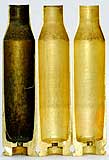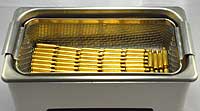Ultrasonic Case Cleaning — What’s the Optimal Dwell Time?
 If you’ve read our feature story on Ultrasonic Cleaning by Jason Baney, you’ve seen the remarkable results that can be achieved with this method. Ultrasonic cleaning has many advantages over traditional tumbling methods of case cleaning. There is no dust or media residue to remove from the brass, and when done right, the cases come out clean and shiney, inside and out, even the primer pockets.
If you’ve read our feature story on Ultrasonic Cleaning by Jason Baney, you’ve seen the remarkable results that can be achieved with this method. Ultrasonic cleaning has many advantages over traditional tumbling methods of case cleaning. There is no dust or media residue to remove from the brass, and when done right, the cases come out clean and shiney, inside and out, even the primer pockets.
In its Benchtalk Archives, Brownell’s has an excellent article discussing Ultrasonic Case Cleaning. Brownell’s staff compares results, with measured dwell times from 5 to 75 minutes, using both Mpro-7 and HCS 200 cleaning solutions. Tests are performed with once-fired and 5X-fired Tactical 20 (Tac20) cases, as well as once-fired .260 Rem Cases. The article also compares the results from ultrasonic cleaning vs. tumbling in walnut media. Below are Brownell’s results for Tac20 cases with the HCS 200 (non-acidic solution). Go to Brownell’s article for MPro7 results and Rem 260 results.
| HCS 200 Cleaning Solution Test Procedure — Solution was de-gassed for 15 minutes, then 63 Tac20 cases were placed in a single layer, in stainless steel mesh basket. The temperature of the starting solution was 102° F. When the cases were removed the temperature was 110° F. Once-Fired Tactical Twenty Cases (HCS 200) — Observations Five-Times Fired Tac20 Cases — Observations |
How Does Ultrasonic Cleaning Work?
 The Brownell’s article explains: “Ultrasonic cleaning uses high-frequency sound waves (generally between 20-80 kHz) to remove a variety of contaminants from objects immersed in a liquid. The result of these high-frequency sound waves is a process called cavitation. These high frequency bursts of ultrasonic energy produce a three-dimensional wave of alternating positive and negative pressure areas as the sound wave passes through the solution. During negative pressure, microscopic cavitation bubbles form and will continue to grown until they reach resonant size. As the positive sound wave passes, the pressure rises rapidly and implodes these tiny bubbles. Before these minuscule bubbles implode they store a tremendous amount of energy. These bubbles can be as hot as 10,000 degrees and have as much as 50,000 lbs per square inch of pressure. This sounds alarming, but you have to remember that these bubbles are microscopic in nature and pose no harm to anything, unless you are a carbon /powder residue deposit on a cartridge case!
The Brownell’s article explains: “Ultrasonic cleaning uses high-frequency sound waves (generally between 20-80 kHz) to remove a variety of contaminants from objects immersed in a liquid. The result of these high-frequency sound waves is a process called cavitation. These high frequency bursts of ultrasonic energy produce a three-dimensional wave of alternating positive and negative pressure areas as the sound wave passes through the solution. During negative pressure, microscopic cavitation bubbles form and will continue to grown until they reach resonant size. As the positive sound wave passes, the pressure rises rapidly and implodes these tiny bubbles. Before these minuscule bubbles implode they store a tremendous amount of energy. These bubbles can be as hot as 10,000 degrees and have as much as 50,000 lbs per square inch of pressure. This sounds alarming, but you have to remember that these bubbles are microscopic in nature and pose no harm to anything, unless you are a carbon /powder residue deposit on a cartridge case!
 When this cavitation bubble implodes near your brass case, it transforms the bubble into a jet about 1/10th of its size. This jet of energy can travel as fast as 400 km/hour. At 43 kHz, as is the frequency for our L & R HCS 200 ultrasonic cleaner, this is happening 43,000 times per second. This micro-burst of extreme energy is responsible for removing contaminants from the surface of your cartridge brass. Ultrasonic cleaning can reach into crevices and inaccessible areas and remove surface debris that can’t be cleaned by any other process.”
When this cavitation bubble implodes near your brass case, it transforms the bubble into a jet about 1/10th of its size. This jet of energy can travel as fast as 400 km/hour. At 43 kHz, as is the frequency for our L & R HCS 200 ultrasonic cleaner, this is happening 43,000 times per second. This micro-burst of extreme energy is responsible for removing contaminants from the surface of your cartridge brass. Ultrasonic cleaning can reach into crevices and inaccessible areas and remove surface debris that can’t be cleaned by any other process.”
Photos and quotes © 2007-2010, Brownells®, Inc. All Rights Reserved, Used with Permission.
Similar Posts:
- Ultrasonic Case Cleaning — Determining the Optimal Dwell Time
- Ultrasonic Case Cleaning — What Is the Best Dwell Time?
- UltraSonic Update — Brownell's Tests Cleaning Solutions
- How to Clean Brass with an Ultrasonic Cleaning Machine
- Ultrasonic Case Cleaning–Tech Tips
Tags: Brass, Cartridge Brass, Cleaning, Solution, Ultrasonic


















I must be having a senior moment or my browser is not displaying part of this item. Please advise where to find the part of this Tech Tip that shows or describes “How to Improve Ultrasonic Case Cleaning Results”.
Fred,
CLICK on the link in the second paragraph and read the full Brownells’ article referenced. Brownells tested two different solutions and discussed the results of different “dwell times” with each. This will help you select the right dwell time for the results you want to achieve. Brownells tester also analyzes the performance of different solutions, both for cleaning ability and how they affect primer seating. That will help you chose among solution options.
I have messed around with ultra sonic cleaning a bit. mostly with info I got here. worked pretty decent although I got a bit of discoloration afterwords. green brass and all.
I mistakenly inferred from the title that a new or updated tip was meant as the articles by Jason Barney and Brownell’s Staff are both from 2006 and have previously been referenced here in 2007. Not that there is anything wrong in reminding us of useful past items (particularly for us old guys — “memory is the second thing to go and no I don’t remember the first” original author unknown.
I have been using a slight variation of Jason Baney’s formulation with great success. I use a 3% solution of Citranox in tap water(degassed in situ for 8 minutes)then processed for 4 cycles (8 min – 480 seconds) on a Lyman Digital Ultrasonic Cleaner. This is followed by one cycle of Tap water and one cycle of distilled water. I have principally been cleaning .223 cases but have used it successfully on discarded range brass both large caliber and small. The limit is 50 small cases or 25 large caliber cases at a time.
Primer pockets for once used brass come out completely clean. Multiple times fired brass may have a small percentage of primer pockets with some slight residue which comes off with a light rotary brass wire brush. In general this regimen works with 48 minutes of overall processing time. The cases are then dried using a shop grade hot air blower – or one used to tighten the covers on model airplane coverings.
Unlike vibratory methods there is no media residue inside the cases and the brass comes out almost as new ready for neck sizing and reloading.
I have a Branson 2510 commercial grade US cleaner. I made a cover for it that holds two beakers directly over the transducers and I use O-rings to adjust their height to the optimum location (can tell by the sounds of the cases vibrating). Each beaker holds 25 308 cases. So, 50 cases get processed each cycle.
I knock out most of the carbon in the primer pockets with a uniforming tool prior to cleaning. When done lightly, it doesn’t take out any additional material. The currently batch of cases have gone over 20 cleaning without losing any due to loose pockets.
I used to use Lemishine as the cleaning agent, but find the new Hornady solution works much better. After 10-15 min. the cases are spotless and shiny. The Branson has a 60 min. timer, so you only need to set it once.
I rinse them off with warm tap water and then give them a final dip in a bucket of warm water with a bit of Lemishine. This prevents water spotting from my hard water. Then I throw them in the empty boxes from cases of soda to dry overnight.
My system is reasonably quick. I cleaned 700 cases the other evening.
I tried a sonic cleaner and found it not worth the effort. I clean all primer pockets with the same uniformer tool used to, well, uniform the pockets. Then toss the lubed sized brass in the vibratory tumbler. They come out as clean as needed and I don’t have wet brass to rinse in distilled water and dried with compressed air. I have found no objective data that suggests that the interior carbon has any effect on accuracy or case life. I did find that the ultrasonic cleaner is great for cleaning muzzle brakes though.
Get a stainless steel mesh basket fine enough so you can stand the brass vertical in the basket.
One hour removes every sign of dirt completely.